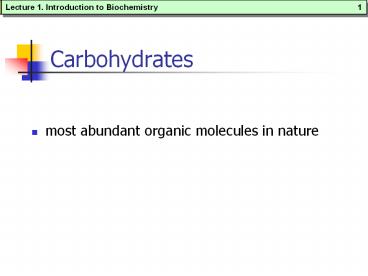Carbohydrates - PowerPoint PPT Presentation
1 / 14
Title:
Carbohydrates
Description:
Title: Lecture 1. Introduction to Biochemistry Author: Hong Li Last modified by: Teacher Created Date: 8/1/2002 9:22:19 PM Document presentation format – PowerPoint PPT presentation
Number of Views:153
Avg rating:3.0/5.0
Title: Carbohydrates
1
Carbohydrates
Lecture 15. Carbohydrates 1
Lecture 14. Subunit Interactions and Quaternary
Structure 1
Lecture 14. Subunit Interactions and Quaternary
Structure 1
Lecture 14. Subunit Interactions and Quaternary
Structure 1
Lecture 14. Subunit Interactions and Quaternary
Structure 1
Lecture 14. Subunit Interactions and Quaternary
Structure 1
Lecture 1. Introduction to Biochemistry
1
- most abundant organic molecules in nature
2
IMPORTANCE
- Photosynthesis stores energy in carbohydrates
- Carbohydrates are the metabolic precursors of all
other biomolecules - Important component of cell structures
- Important function in cell-cell recognition
3
Carbohydrate Classes
- Monosaccharide
- Simple sugars, can not be broken down further
- general formula (CH2O)n
- Examples
4
Alpha vs Beta glucose
5
- Can be
- Aldoses
- Contain aldehyde
- Ketoses
- Contain ketones
6
- Disaccharide - two sugars
- formed by dehydration synthesis
7
- glucose fructose ? sucrose water
- table sugar
- glucose galactose ? lactose water
- milk sugar
- glucose glucose ? maltose water
- malt sugar
8
Carbohydrate Classes
Lecture 15. Carbohydrates 8
- Disaccharides
- Simplest oligosaccharides
- Contain two monosaccharides linked by a
glycosidic bond
9
Oligiosaccharide
- short chain 3 -10 monomers long
- Identification on cells
10
Carbohydrate Classes
- Polysaccharides
- Polymers of monosaccharides
11
Polysacchrides
Lecture 15. Carbohydrates 11
- Starch and glycogen are storage molecules
- Chitin and cellulose are structural molecules
- Cell surface polysaccharides are recognition
molecules.
12
Polysacchrides
Lecture 15. Carbohydrates 12
- Glucose is the monosaccharides of the following
polysacchrides with different linkages and
banches - a(1,4), starch (more branch)
- a(1,4), glycogen (less branch)
- b(1,4), cellulose (cell walls of all plants)
- b(1,4), Chitin similar to cellulose, but C2-OH is
replaced by NHCOCH3 (found in exoskeletons of
crustaceans, insects, spiders)
13
Carbohydrates
- Polysaccharide - glycogen
- many glucose units in a branching pattern
- liver and skeletal muscle are good sources
- hormone insulin stimulates glycogen production
(glycogenesis) - hormone glucagon stimulates glycogen breakdown
(glycogenolysis) - glycogen is found in animal cells as an inclusion
14
Carbohydrates
- Starches are complex carbohydrates, often two
polysaccharide chains - plants make starches, including the indigestible
cellulose - examples - wheat, rice, corn, potato, cassava,
rye, barley































